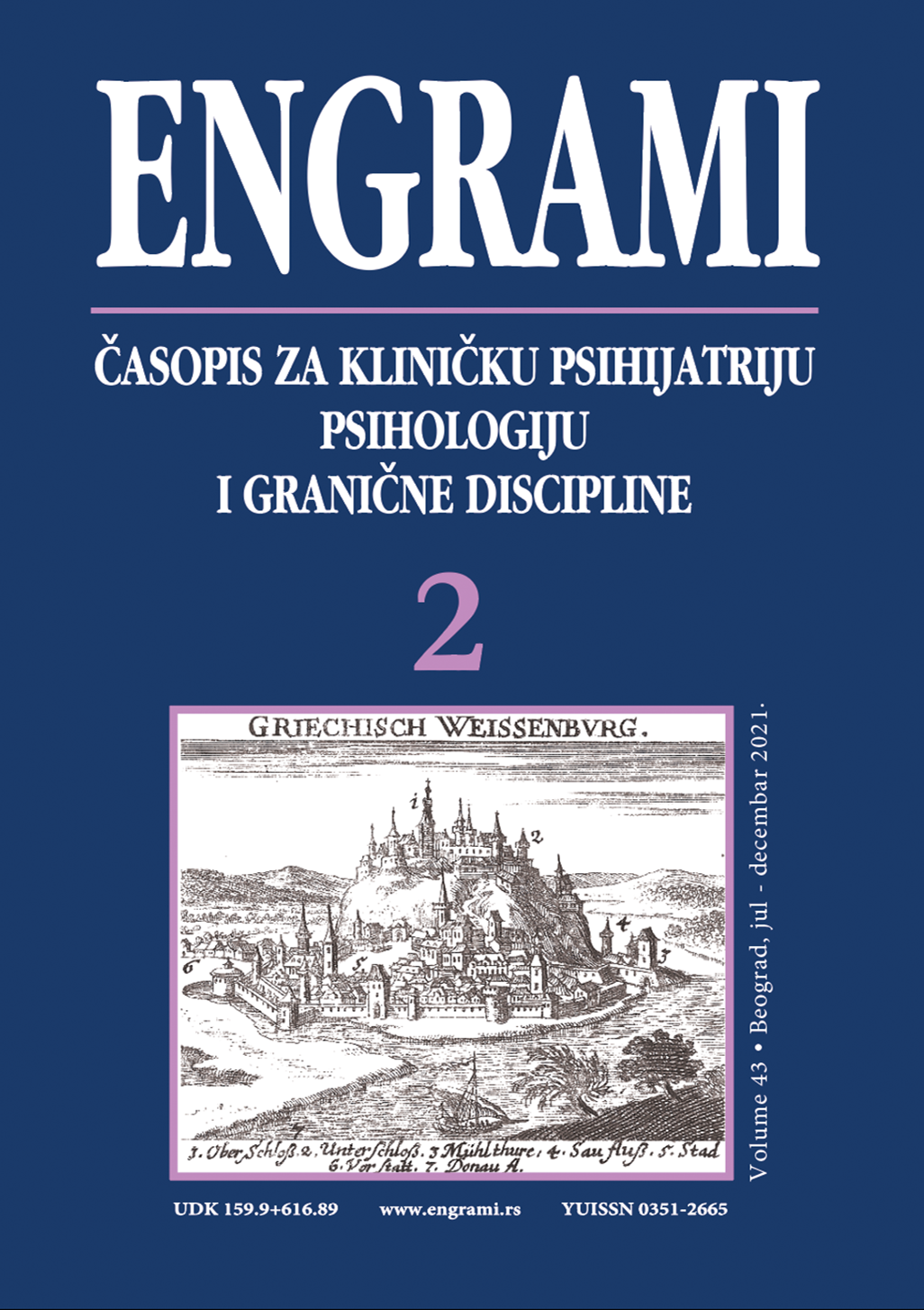Srpska adaptacija Skale ranjivosti prema zaraznim bolestima (PVD)
Sažetak
Godina 2020 je pokazala u novom svetlu značaj borbe protiv infektivnih bolesti. Pored fiziološkog imunog sistema individua poseduje i bihevioralni imuni sistem. Ključne komponente ovog sistema su sklonost ka gađenju, percipirana ranjivost u odnosu na bolesti, zdravstvena anksioznost i druge. Trenutno ne postoji ni jedan instrument koji meri percipiranu ranjivost prema bolesti na srpskom jeziku. Iz tog razloga sproveli smo istraživanje kako bismo stručnoj javnosti obezbedili instrument koji bi omogućio istraživanja ove vrlo aktuelne i relevantne teme, Skale ranjivosti prema zaraznim bolestima (Perceived Vulnerability to Disease Scale; PVD). Na uzorku od 500 ispitanika, od kojih se 82.6% izjasnilo da su ženskog pola, sa srednjom vrednosti starosti od 20.53 godine (SD=1.27 min=19; max=26), izvršili smo konfirmatornu faktorsku analizu. Postojeća dva modela strukture skale nisu pokazali zadovoljavajuću podudarnost. Zbog toga smo primenili dvofaktorsko rešenje koje odgovara našim nalazima. Dve subskale su Percepcija opasnosti od zaraze (PI) i Averzija prema mikrobima (GA) ali morali smo da izbacimo dve stavke kako bismo dobili ovo rešenje. Testirali smo ovu skalu sa drugim konstruktima kako bismo utvrdili divergentnu validnost i dobili smo zadovoljavajuće rezultate. Zaključujemo da je srpski prevod PVD skale validan instrument koji se može koristiti u daljim istraživanjima.
Reference
Murray D, & Schaller M. The behavioral immune system: Implications for social cognition, social interaction, and social influence. Adv Exp Soc Psychol 2016; 53: 75-129.
Mortenson C, Becker D, Ackerman J, Neuberg S, & Kenrick D. Infection breeds reticence the effects of disease salience on self-perceptions of personality and behavioral avoidance tendencies. Psychol Sci 2010; 21(3): 440-477.
Ackerman J, Hill S, & Murray D. The behavioral immune system: Current concerns and future directions. Soc Personal Psychol Compass 2018; 12(2).
Diaz A, Soriano J, & Belena A. Perceived Vulnerability to Disease Questionnaire: Factor structure,psychometric properties and gender differences. Pers Individ Dif 2016; 101: 42-49.
Tybur J, Wessekdijk L, & Jern P. Genetic and Environmental Influences on Disgust Proneness, Contamination Sensitivity, and Their Covariance. Clin Psychol Sci 2020; 8(6): 1054-1061.
Schaller M, & Murray D. Pathogens, personality and culture: Disease prevalence predictors worldwide variability in sociosexuality, extraversion, and openness to experience. J Pers Soc Psychol 2008; 95(1): 212-221.
Prokop P, Usak M, & Fancovicova J. Risk of parasite transmission influences perceived vulnerability to disease and perceived danger of disease-relevant animals. Behav Processes 2010; 85(1): 52-57.
De Coninck D, d'Haenens L, & Matthijs K. Perceived vulnerability to disease and attitudes towards public health measures: COVID-19 in Flanders, Belgium. Pers Individ Dif 166.
Cox R, Jessup S, Lueber M, & Olatunji B. Pre-pandemic disgust proneness predicts increased coronavirus anxiety and safety behaviors: Evidence for a diathesis-stress model. J Anxiety Disord 2020; 76.
Rokvic N. Validation of the Serbian Translation of the Disgust Propensity and Sensitivity Scale (DPSS). Psihologijske teme 2020; 29(3): 631-648.
Park J, Faulkner J, & Schaller M. Evolved disease-avoidance processes and contemporary anti-social behavior: Prejudicial attitudes and avoidance of people with physical disabilities. Journal of Nonviolent Behavior 2003; 27: 65-87.
Olatunji B, Adams T, Ciesielski B, David B, Sarawagi S, & Broman-Fulks J. The three domains of disgust scale: Factor structure, psychometric properties, and conceptu al limitations. Assessment 2012; 19(2): 205-225.
Olatunji B, Taylor S, & Zald D. Sex differences in the etiology of disgust sensitivity: A preliminary behavioral genetic analysis. J Anxiety Disord 2019; 65: 41-46.
Duncan L, Schaller M, & Park J. Perceived vulnerability to disease: Development and validation of a 15-item self-report instrument. Pers Individ Dif 2009; 47(6): 541-546.
Browne MW, & Chudeck R. Alternative ways of assessing model fit. In KA Bollen, & JS Long, Testing structural equation models (pp. 136-162). Newbury Park CA: Sage; 1999.
Bentler PM. Comparative fit indexes in structural models. Psychol Bull 1990; 107(2): 238-246.
Tucker L, & Lewis C. A reliability coefficient for maximum likelihood factor analysis. Psychometrika 1973, 38, 1-10.
Akaike H. Factor Analysis and AIC. In E Parzen, K Tanabe, & G Kitagawa, Selected Papers of Hirotugu Akaike. Springer Series in Statistics (Perspectives in Statistics) (pp. 371-386). New York: Springer; 1987.
Schwarz G. Estimating the dimension of a model. Ann Stat 1978; 6(2): 461-464.
Diener E, Emmons R, Larson R, & Griffin S. The Satisfaction With Life Scale. J Pers Assess 1985; 49(1): 71-75.
Vasić A, Sarčević D, & Trogrlić A. Zadovoljstvo zivotom u Srbiji [Life satisfaction in Serbia]. Primenjena psihologija 2011; 4(2): 151-177.
Ashton M, Lee K, & Goldberg L. The IPIP–HEXACO scales: An alternative, public-domain measure of the personality constructs in the HEXACO model. Pers Individ Dif 2007, 42(8), 1515-1526.
Medjedovic J, & Bulut T. The mini IPIP-6: short, valid, and reliable measure of the six-factor personality structure. Primenjena psihologija 2017; 10(2): 185-202.
Cavanagh K, & Davey G. The development of a measure of individual differences in disgust. British Psychology Society 2000. Winchester, UK.
Lovibond P, & Lovibond S. The Structure of Negative Emotional States: Comparioson of the Depression, Anxiety, Stress Scales (DASS) with the Beck Depression and Anxiety Inventory. Behav Res Ther 1995; 33(3): 335-343.
Jovanovic V, Gavrilov-Jerkovic V, Zuljevic, D, & Brdaric D. Psihometrijska evaluacija Skale depresivnosti, anksioznosti i stresa–21 (DASS–21) na uzorku studenata u Srbiji [Psychometric evaluation of the Depression Anxiety Stress Scales-21 (DASS21) in a Serbian student sample]. Psihologija 2014; 47(1): 93-112.
Magallares A, Fuster-Ruiz De Apodaca M-J, & Morales J-F. Psychometric properties and criterion validity of the Perceived Vulnerability to Disease Scale (PVD) in the Spanish population. Rev Psicol Soc 2017; 32(1): 164-195.

